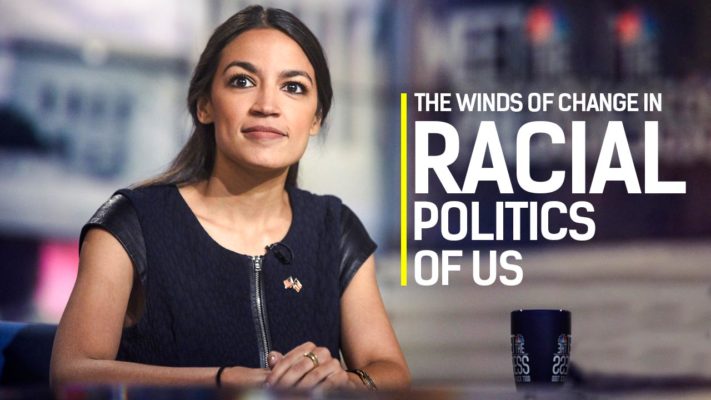
The Sudden Left Shift In The Democratic Party
Despite the concentration stressed on the extreme right politics of Donald Trump, the truth is that America is undergoing one of the biggest political shifts the country has seen in years and it has to thank the Democratic Party for it. The white liberals have taken up a stand so extreme left with respect to issues on racism in the last half a decade that they can be termed to be even left of the representative black voter. Researchers have begun to determine a sustained but rapid change owing to the ‘Great Awokening’. The Great Awokening refers to the protests that had roughly begun in 2014 when activists had taken to putting the omnipresent digital media and social media at the advantage of using them as a tool to bring the American audience up to date with stories that might otherwise have been local news.
The white Democrats have begun to demonstrate, almost in a dramatic manner, high concerns for racial discrimination and inequality, while encouraging immigration and racial diversity. However, on the downside, with more and more white Democrats being vocal about issues on racial discrimination and inequality, the racial traditionalist Democrats have opted their way out of the Democratic Party pushing Donald Trump into victory. If there is one thing that is clear from this whole chain of events, it is that white racism is on its way to a rise in America.
Trump might have been the one to expose the white racial antipathy more clearly than ever, however, concurrently, the white liberalists have made themselves well adjusted with racism. The deep-rooted reality turns out to be that the Awokening has rendered itself to be inspirational for a huge cluster of white liberal Americans who have set in motion to acknowledge the systemic racial bigotry as a primary crisis in the American way of life.
The Greater The ‘Awokening’, The Bigger The Platform Shifts
The 1996 platform document for the Democratic Party stated, “In 1992, our borders might as well not have existed. Drugs flowed freely. Illegal immigration was rampant. Criminal immigrants, deported after committing crimes in America, returned the very next day to commit crimes again.” Again, in 2008, when the Democratic Party claimed to support a course to American citizenship for the immigrants who were unauthorized, even then the party’s platform document read, “We cannot continue to allow people to enter the United States undetected, undocumented, and unchecked.” While in 2008, the Democratic Party had committed itself to be “tough on violent crime”, by the year of 2016, the party settled for “ending mass incarceration” while also disparaging the drug war and exposing “the discriminatory treatment of African Americans, Latinos, Asian Americans and Pacific Islanders, and American Indians.”
Perhaps, what can be taken as the most unambiguous indication of the current shift happening is the overturned politics of recompenses. Reparations or compensations had always been off the table for the Democratic Party even ten years before. Rather, people like Rush Limbaugh would attempt at gaining political advantage by labelling the administrative and economic policies of Obama as an outward appearance for reparations. However, old times aside, it is the Democratic Party itself that has now surrendered itself to such politics even though their original proposed policies are racially unbiased.
The extreme left shift on reparations, criminal justice, and immigration are frequently presented as a reflection of the electoral blow of the non-white voters. However, that does not completely account for the revolutionary shift in racial politics as the fundamental demographics have not altered fast enough to back up the change’s pace. The key disparity is that the white Democrats have altered their views in haste, thereby transforming the operating political space of the Democratic Party.
Reforming Politics Through Racial Realignment
Matthew Yglesias, an American journalist, writes, “Ever since the 2016 election, analysts have been stuck in a tedious argument between the observation that racial resentment was a key predictor of which voters flipped to Trump’s camp and those who prefer to ascribe Trump’s ascension to some form of “economic anxiety.”” The most important point that one should understand here is that the term, “racial resentment”, often employed by the political scientists, significantly measures the political views instead of any form of interpersonal hostility. The General Social Survey of America had raised an important point by asking the citizens to agree or disagree with the statement, “Irish, Italians, Jewish, and many other minorities overcame prejudice and worked their way up; blacks should do the same without special favors.” While one-third of the African American citizens had disagreed, it still could not beat the 45% of the white Democrat liberals who disagreed.
As a part of his 2016 campaign, what Trump intended was to amplify the emphasis on the themes of racial conflict, hence furthering his appeal to the racially conformist white voters who might have supported the Democratic Party previously on different grounds. However, it must be understood that the larger reason for such events is not Trump but the Awokening itself since the Democrats have all of a sudden shifted the criterions with respect to the kind of racial opinions that is expected of a good liberal to avow. The uprising racial liberalist views of the file rank white members of the Democratic Party have the leaders opening conversations about “systemic racism”. There are strong indications being passed on to the base of the party regarding the type of racial attitudes required to be held by a Democrat.
The Other Side Of The Trump Card
One of the many marked outcomes of the Awokening is the tag on Trump as detestable personnel in the politics of America. To this respect, Yglesias states, “To the extent that white liberals now see racism as an enormous looming challenge for the country in a way they did not in the relatively recent past, Trump is very much the personification of that challenge. And thus, given the perfect enemy, it’s perhaps not surprising that much of the newly woke attitude is, in crucial respects, a bit vague in its precise policy implications. Everyone is talking about reparations and “institutional racism,” but nobody has a precise policy program for tackling either of those things. Congress passed the prison reform bill, the First Step Act, but there’s little consensus on what the next step is. But it’s clear that getting rid of Trump is a key part of the story, and a key argument in the 2020 primary is over who is best suited to do that.”
Nonetheless, and as evidence would suggest, the electorate’s racial polarization serves as a godsend to the fortunes of Trump owing to the fact that the all-new political style of the Democratic Party post the Great Awokening would only push Trump towards victory. The reality is that social uprisings do not follow the orders of partisan political principles. The 1840s and the 1850s might have seen the Great Awokening set free the moral passion in citizens to crush the Whig Party and ensconce the dominance of the South on the political power temporarily. However, it never could get rid of the abolitionist attitude. Therefore, right on board with Yglesias when he suggests, “While the Great Awokening might drive some Democrats into Trump’s arms now, the sustained phenomenon is forcing the Democratic Party to confront the legacy of America’s racial caste system squarely. The next Democratic president will have to do the same.”














